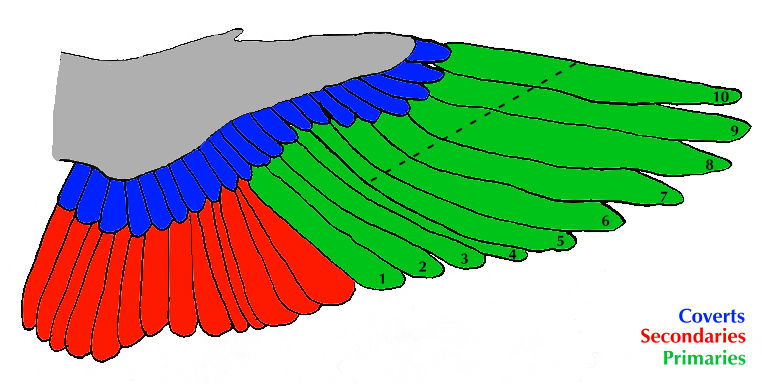Wing Clipping

This is intended to be used as a source for clipping your cockatiel's wings correctly. It is by no means a
substitute for the qualified advice of your avian vet. If you have any doubts about clipping your birds' wings, then don't
do it. Takoda Aviary assumes no liability for anything that happens to your bird as a result of our instructions.
Clipping the wings is a fairly simple matter that should be done a few months after every molt to ensure
that the bird is still clipped. There are a lot of webpages out there that explain in minute detail how to clip your bird's wings,
but provide no illustrations. There are also a lot of webpages out there that tell you how to do it wrong. I've actually gone
to a small animal vet (another reason why you should ONLY take your bird to the avian vet) and had them clipped incorrectly.
On this page you will see how to do a wing clip correctly. This page is not intended as even a
beginner's basics in wing anatomy, please visit the rest of our site
for more information on wing anatomy.

Notice how this picture is color coded. The GREEN color is the
primaries, these are the only feathers that should ever been cut during a wing clip. Ever. Notice
how I've made the secondaries red, like a stoplight! Don't cut these. The
coverts are the feathers that cover the flight feathers.
So, you can see, the first ten feathers of the wing can be clipped. However, this is rarely, if ever,
needed. The whole point of a wing clip is to not allow the bird to gain altitude. Some breeders and small animal vets will
clip all ten. This is called a severe wing clip. It causes the bird to fall to the ground like a rock, increasing the likelihood
that the bird will injure itself, possibly by breaking its keel or even its neck! After all, it can't slow itself with its wings, the
feathers have all been hacked off!
A proper wing clip allows the bird to glide gently to the ground without gaining height. This helps
prevent injury to the bird, and keeps you from chasing your pet all over the house.
To clip the wing: Get someone to help you. It takes two, baby, it takes two, baby!
Have the person holding the bird support the wing at the joint. Holding the bird's body and the wing takes kind of a knack,
if the person doesn't feel comfortable doing it, try again another time, or you hold and have them clip.
You must clip both wings evenly. You don't want the bird to go into a spiral
and injure itself just as if it had a severe wing clip. Clip the first three primary feathers off each
side, just below the coverts on top. Take care not to cut any of the coverts.
See if the bird can fly. Then
clip one feather at a time from both sides, until you reach the point where the bird is gliding downwards gently. Keep in mind
how many you clipped, it will make it quicker in the future. My birds generally need 4-5 feathers clipped. Each bird varies
in its ability to fly, which is why you should only clip one feather at a time after the initial three.
This is not the only correct way in which to clip wings. There is also a method in which you start
at the back primary (#1) and clip inwards from there. That gives the bird a more natural look,
but more feathers must be cut off. You can also leave #10, and, if you wish, #9, intact, and start clipping at #8. This also
gives the bird a more natural look, but keep in mind, more feathers will have to be cut. There is a fairly new method where
the feather is clipped right at the quill, something that sounds rather prickly for the bird, and stressful, since you have to pick
through its feathers to get at the quill. I don't recommend it.
Be careful of blood feathers. If you see a feather shaft that is red and looks like it's full of blood,
it is. Don't clip it. Blood feathers are feathers that are still growing, and still receiving a blood supply.
If you accidentally clip it, apply cornstarch and pressure to the feather at once. If you have pulled a wing
feather before, you can pull the feather, immediately following with cornstarch and pressure, but if you haven't, leave it alone.
If in doubt, CALL THE AVIAN VET!!
How I've seen wings clipped wrong. It's kind of sad how many people clip the wings wrong.
I've seen all ten primaries clipped, and all the tail feathers were thus broken, and the owner didn't understand why the tail
feathers kept breaking like that. I've seen all ten primaries clipped AND the coverts on top clipped too! I've seen all the
primaries AND secondaries clipped. You only need to clip the first 3-6 primaries. Occasionally, a very strong flier may
warrant a heavier clip. I've never clipped more than six feathers from a cockatiel.
Note: The primaries end at the first bend in the wing. My drawing has attempted
to illustrate this. I'm no Da Vinci. Also notice the coverts are not drawn to scale.
|
|
|